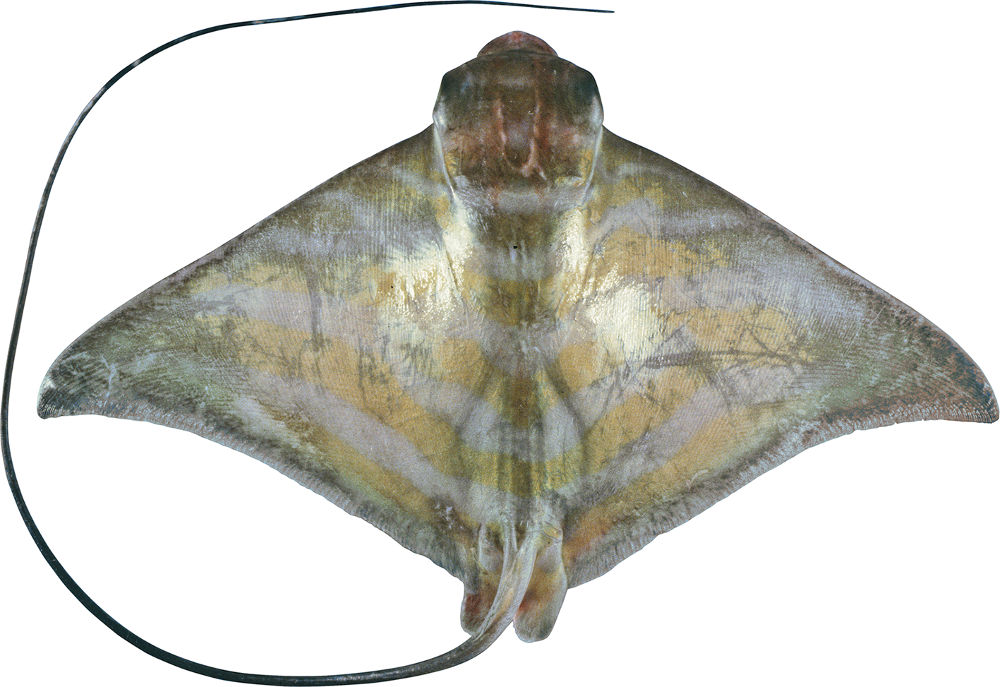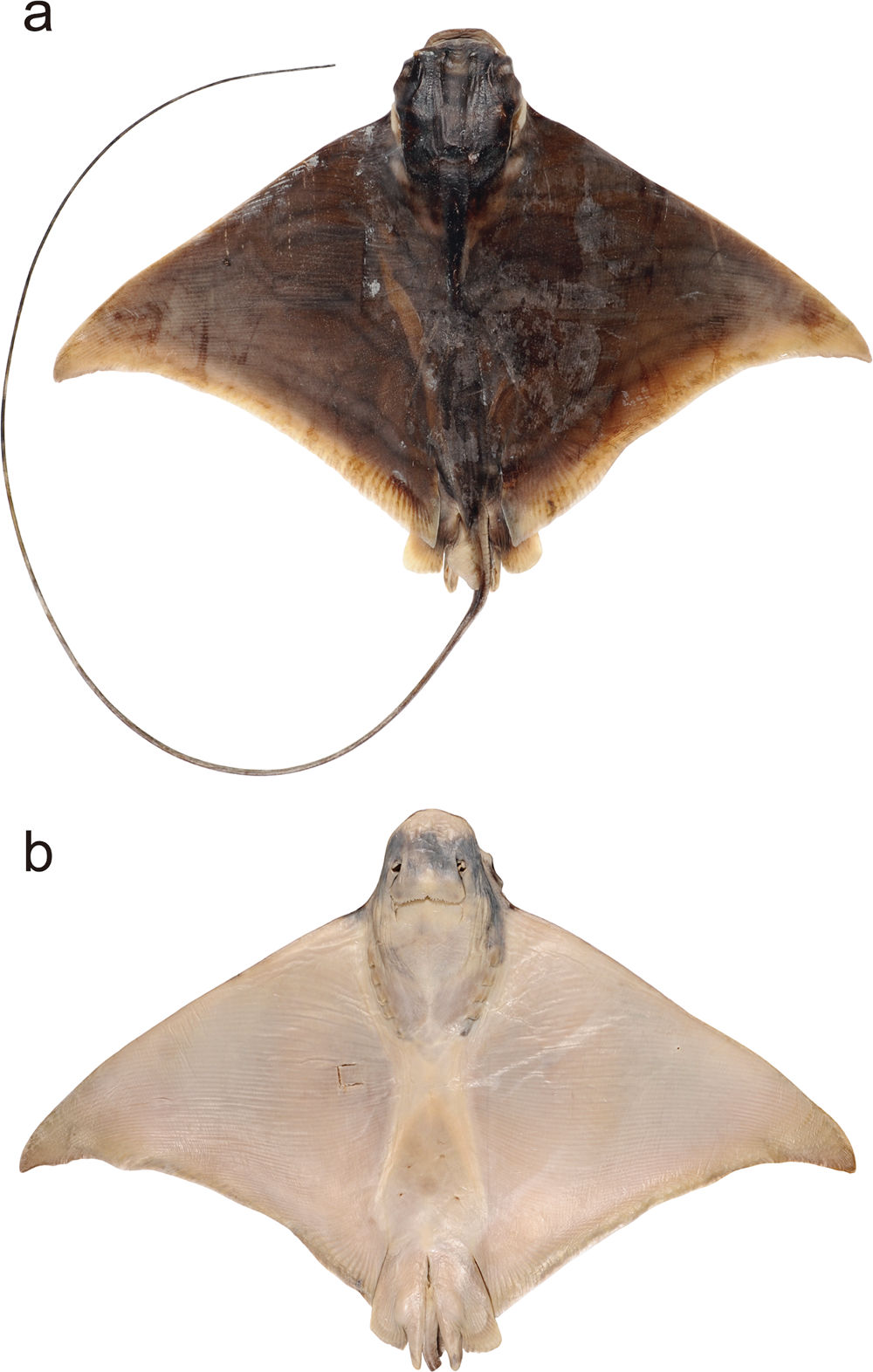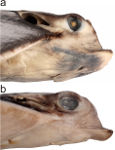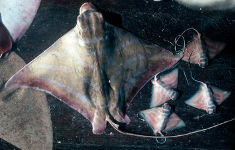Aetomylaeus caeruleofasciatus
White, Last & Baje, 2015
Classification: Elasmobranchii Myliobatiformes Myliobatidae
Reference of the original description
Aetomylaeus caeruleofasciatus, a new species of eagle ray (Myliobatiformes: Myliobatidae) from northern Australia and New Guinea. Ichthyological Research, 63(1), 94–109
Aetomylaeus caeruleofasciatus, a new species of eagle ray (Myliobatiformes: Myliobatidae) from northern Australia and New Guinea. Ichthyological Research, 63(1), 94–109
Image of the original description

Aetomylaeus caeruleofasciatus White, Last & Baje, 2015; Dorsal view, juvenile paratype CSIRO CA 1254, male 230 mm DW, fresh © William T. White, Peter R. Last, Leontine Baje

Aetomylaeus caeruleofasciatus White, Last & Baje, 2015; Dorsal view, juvenile paratype CSIRO CA 1254, male 230 mm DW, fresh © William T. White, Peter R. Last, Leontine Baje
Types
Aetomylaeus caeruleofasciatus
Holotype: CSIRO: H 6629-01; Paratype: CSIRO: C 4470; CSIRO: CA 1149; CSIRO: CA 1250; CSIRO: CA 1254; CSIRO: T 684; CSIRO: H 958-01; CSIRO: H 958-02; CSIRO: H 958-03; CSIRO: H 958-04; CSIRO: H 958-05; CSIRO: H 3919-01; KFRS: unregist. (field code 220559); KFRS: unregist. (field code 220600); KFRS: unregist. (field code 220447); KFRS: unregist. (field code 210386); KFRS: unregist. (field code 210356); NTM: S 11786; NTM: S 12952; NTM: S 12956; QM: I 12534; QM: I 27894;
Aetomylaeus caeruleofasciatus
Holotype: CSIRO: H 6629-01; Paratype: CSIRO: C 4470; CSIRO: CA 1149; CSIRO: CA 1250; CSIRO: CA 1254; CSIRO: T 684; CSIRO: H 958-01; CSIRO: H 958-02; CSIRO: H 958-03; CSIRO: H 958-04; CSIRO: H 958-05; CSIRO: H 3919-01; KFRS: unregist. (field code 220559); KFRS: unregist. (field code 220600); KFRS: unregist. (field code 220447); KFRS: unregist. (field code 210386); KFRS: unregist. (field code 210356); NTM: S 11786; NTM: S 12952; NTM: S 12956; QM: I 12534; QM: I 27894;
Description :
Citation: Aetomylaeus caeruleofasciatus White, Last & Baje, 2015: In: Database of modern sharks, rays and chimaeras, www.shark-references.com, World Wide Web electronic publication, Version 12/2025
Please send your images of "Aetomylaeus caeruleofasciatus" to info@shark-references.com

Aetomylaeus caeruleofasciatus White, Last & Baje, 2015; Holotype, (CSIRO H 6629-01, adult male 436 mm DW, preserved), dorsal and ventral view (excluding tail) © William T. White, Peter R. Last, Leontine Baje

Aetomylaeus caeruleofasciatus White, Last & Baje, 2015; Holotype, (CSIRO H 6629-01, adult male 436 mm DW, preserved), dorsal and ventral view (excluding tail) © William T. White, Peter R. Last, Leontine Baje
Common names
Blue-banded Eagle Ray
Blue-banded Eagle Ray
Short Description
Original Diagnosis after WHITE, LAST & BAJE, 2015 [22847]: A small Aetomylaeus (attaining about 590 mm DW) with the following combination of characters: dorsal surface greenish to yellowish brown with a series of seven transverse pale bluish bands (sometimes faint), without dark spots or blotches; ventral surface whitish, pectoral fins usually not dusky distally; tail rather long (1.5–1.8 times DW); no stinging spine; head short and narrow; rostral lobe fleshy, relatively broad, short, with a rounded apex; teeth in seven rows in each jaw, with a broad median row flanked by three smaller rows on each side; dorsal-fin origin level with pelvic-fin insertions; pectoral-fin radials 84–88 (excluding concealed propterygial radials anterior of eyes); total vertebral centra (including synarcual) 80–86; males with 14 or 15 pelvic radials (excluding clasper); females with 20 or 21 pelvic radials; males mature by 434 mm DW.
Original Diagnosis after WHITE, LAST & BAJE, 2015 [22847]: A small Aetomylaeus (attaining about 590 mm DW) with the following combination of characters: dorsal surface greenish to yellowish brown with a series of seven transverse pale bluish bands (sometimes faint), without dark spots or blotches; ventral surface whitish, pectoral fins usually not dusky distally; tail rather long (1.5–1.8 times DW); no stinging spine; head short and narrow; rostral lobe fleshy, relatively broad, short, with a rounded apex; teeth in seven rows in each jaw, with a broad median row flanked by three smaller rows on each side; dorsal-fin origin level with pelvic-fin insertions; pectoral-fin radials 84–88 (excluding concealed propterygial radials anterior of eyes); total vertebral centra (including synarcual) 80–86; males with 14 or 15 pelvic radials (excluding clasper); females with 20 or 21 pelvic radials; males mature by 434 mm DW.
Dentition
Original Diagnosis after WHITE, LAST & BAJE, 2015 [22847]: Teeth in seven rows in each jaw, coalesced to form plates; middle series of teeth in both jaws broad and hexagonal, flanked by three rows of much smaller, similarly sized, diamond-shaped teeth on each side arranged in a pavement-like fashion; median tooth row transverse in upper jaw, slightly curved in lower jaw; median tooth row 6–8 times width of lateral tooth rows; lower jaw tooth plate width 4.2 (3.8–4.8)% DW, upper jaw tooth plate width 4.5 (4.4–5.7)% DW.
Original Diagnosis after WHITE, LAST & BAJE, 2015 [22847]: Teeth in seven rows in each jaw, coalesced to form plates; middle series of teeth in both jaws broad and hexagonal, flanked by three rows of much smaller, similarly sized, diamond-shaped teeth on each side arranged in a pavement-like fashion; median tooth row transverse in upper jaw, slightly curved in lower jaw; median tooth row 6–8 times width of lateral tooth rows; lower jaw tooth plate width 4.2 (3.8–4.8)% DW, upper jaw tooth plate width 4.5 (4.4–5.7)% DW.
Remarks
shark-references Species-ID=14405;
shark-references Species-ID=14405;


















